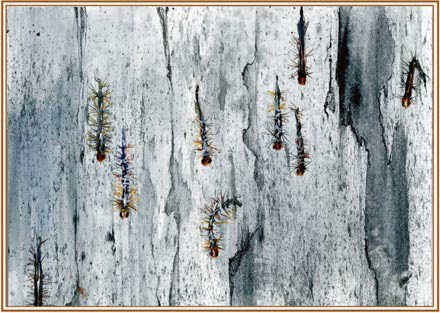
Out-of-control fungi that kill entire populations across a wide geographic area are usually viewed with utter horror: late blight on our garden tomatoes and potatoes and the white-nose syndrome that kills bats come to mind as recent examples. But Entomophaga maimaiga, a fungus that kills gypsy moth caterpillars, and – thank goodness – only those of the gypsy moth, has been welcomed with open arms. It is being credited, at least tentatively, with widespread gypsy moth population crashes throughout much of the moth’s range in the U.S.
You will remember that gypsy moths were imported from France and accidentally released in 1868 or 1869 in Medford, Massachusetts. Once established, this Eurasian species spread relentlessly, defoliating forests, parks, suburbs, and city street trees in ever larger areas each year. The Northeast and Great Lakes regions experienced the most severe outbreaks, but today, gypsy moths are found in almost every state.
The moth-killing fungus Entomophaga maimaiga, also known as Em, was imported from its native Japan to the Boston area in 1910 and again in 1911 in the hope that it would kill gypsy moths here, but those introductions failed. For the next 75 years, the damage caused by gypsy moths continued to grow and was especially devastating to oak trees. In 1985 and 1986, entomologists tried again to introduce Em. Spores were injected into gypsy moth larvae in New York and Virginia. Once again, the fungus did not take hold.
Then, in early June of 1989, out of the blue, Em started killing gypsy moths in huge numbers in southwestern Connecticut. This time, the fungus spread extremely rapidly, mostly without human assistance, and by 1992 Em was killing gypsy moths by the millions throughout most of their U.S. range. The source of this unexpectedly successful biological phenomenon is a mystery. By the end of 1989, its first season, Em had already been found in six other northeastern states. Because of this surprising virulence, and because it was geographically isolated from the New York and Virginia introductions, it is believed to have originated from an accidental introduction and not the deliberate attempts to establish it. The fungus isn’t found at the leading edge of the moth’s expanding range, but gypsy moths beware, it will soon catch up with you.
Em seems to be a competent and formidable contender in the war against gypsy moths. Well tuned to the moth’s life cycle, its spores are ready to germinate and penetrate a larva’s cuticle soon after the larva emerges from its egg early in spring.
First, an infected larva loses its plump profile, and then it shrivels as its insides are devoured and converted to fungus. After the caterpillar dies in four to eight days, the fungal biomass undergoes another change as it shifts to spore production. Spore-producing structures emerge from the carcass, and large numbers of spores are released. The dead caterpillar’s white hairs are coated with spores, and they are carried by the wind to other caterpillars. In the end, just the skin of the corpse remains, hanging by its prolegs in the foliage.
The effect isn’t instant, of course. Gypsy moth caterpillars may cause some damage to tree leaves before they sicken, but as long as they die before transforming into adults, next year’s greenery will be safe.
A bit later in the season, the fungus changes its strategy. Instead of producing short-lived, windborne, asexual spores, Em produces long-lived, sexual spores that overwinter in soil. These resting spores can survive for two or three years without their insect hosts.
Unlike most chemical insecticides, fungi are often very picky about whom they kill. They commonly attack just one species. Em is one of more than 700 recognized species of insect- and mite-destroying fungi.
Introducing organisms to control pests is a gamble, and many well-intentioned efforts have backfired. A fly (Compsilura concinnata) that was introduced to fight gypsy moths and other pests has had a limited effect on the intended targets but has instead taken a toll on many beautiful native moth species, including the cecropia moth. [Editor’s note: See the cecropia moth and caterpillar on page 46.]
So far, the dynamics of most insect populations are beyond human understanding and remain impervious to our efforts to interfere. No one dares hope that Em will eliminate gypsy moths, although it has performed surprisingly well. Could it change its ways and attack desirable insects? Or lose some of its awesome virulence over time? So far, our team, the team that loves towering oaks and native species, is doing well. About all people can do is stay out of the way and hope that Em remains effective and well mannered.


Discussion *